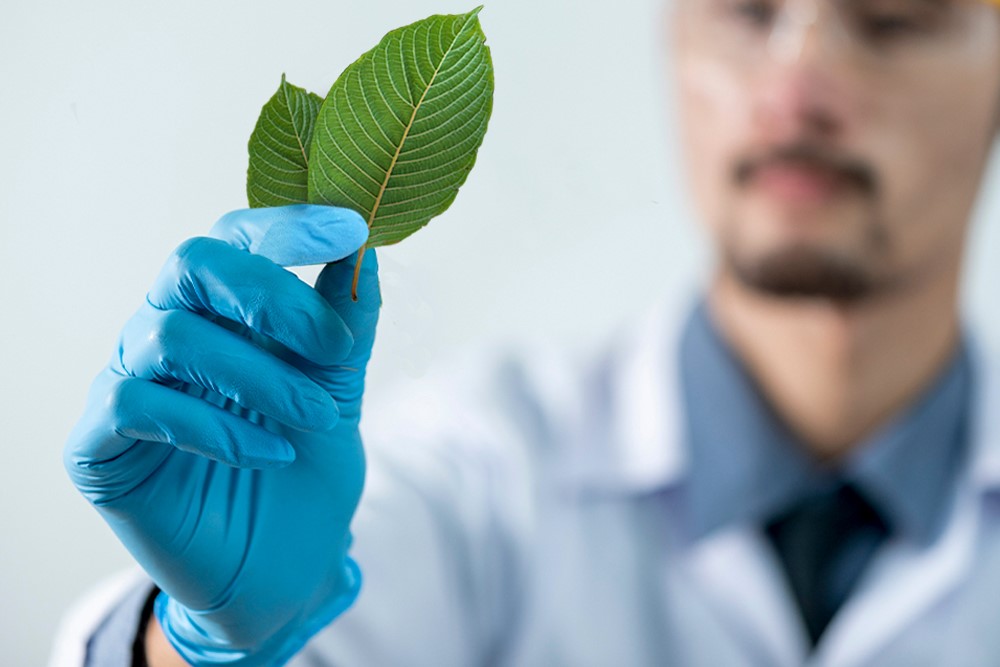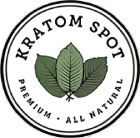
Even long-time kratom users may be a little hazy on how exactly kratom works in the body. It’s a bit like a car engine for most users: they don’t need to know how it works, just that it works. But when it comes to your health and wellness, it pays to be informed. So today we’ll be doing a deep-dive on kratom alkaloids — the natural phytochemicals responsible for the unique effects of kratom.
We’ll cover the basics, like what kratom alkaloids are, the most abundant alkaloids, and what we’ve learned from the recent clinical study of kratom alkaloids. We’ll also provide a list of all currently known kratom alkaloids with links for further learning on each!
What are Alkaloids?
Plants, like all living things, are made up of natural chemical compounds. In the case of plants, we refer to these as “phytochemicals” (literally, “plant chemicals”). Alkaloids are a special class of chemical compounds. They are present in a wide variety of plants, including poppy, ergot, and mitragyna speciosa (the evergreen tree from which kratom is derived).
Of the many phytochemicals, alkaloids are somewhat special. Alkaloids tend to have strong physiological effects when ingested, even in minimal doses. Depending on the alkaloid concentration in a given plant, these effects can vary widely — from anti-inflammatory to mood-elevating effects and more.
The potency and diversity of alkaloid effects have led to extensive clinical research and the development of several alkaloid-based drugs. Two of the best known alkaloids, for instance, have very different effects when ingested.
Caffeine, an alkaloid commonly found in coffee beans and tea leaves, is widely used for its mild stimulant effects. By contrast, morphine is an alkaloid found in opium poppies, and it causes a strong sedative and comforting effect. Different plants produce other alkaloids — but most, it seems, have a significant impact on organisms that ingest them.
Although alkaloids were initially believed to be produced only by plants, recent research has uncovered that they are naturally present in certain animal species!
The Most Common Kratom Alkaloids
Mitragynine and 7-hyrody-mitragynine are the two most abundant kratom alkaloids and are largely responsible for the effects you may experience. In fact, these two alkaloids are considered selective, acting on the µ-subtype opioid receptors (MORs) in our systems.
Again, different plants have different alkaloid concentrations, and certain alkaloids are found in only one or two plant species.
When it comes to kratom, research has uncovered at least 28 different kratom alkaloids. Of these, it is believed that mitragynine and 7-hydroxymitragynine have the most significant effects when ingested.
- Mitragynine is the most abundant kratom alkaloid, making up roughly 66% of total kratom alkaloid concentration. However, this concentration varies based on several factors, including growing conditions, harvesting time, and strain of kratom. Tests on kratom samples from different strains show that mitragynine levels tend to be higher in green vein and white vein kratom strains. Mitragynine levels tend to be lower in Malaysian kratom strains. Mitragynine has a half-life of 3.85 ± 1 hour, depending on the individual’s biochemistry
- 7-hydroxymitragynine is a much rarer kratom alkaloid, making up roughly 2% of total alkaloid content. It tends to be the fourth most abundant alkaloid kratom, though its concentration varies significantly based on a number of factors. Red vein kratom strains tend to have higher than average 7-hydroxymitragynine content. The strain with the highest levels of 7-hydroxymitragynine is red vein Maeng Da. 7-hydroxymitragynine has a half-life of 2.5 ± 0.7 hours, so it affects the body for much less time than does mitragynine
As the growing kratom plant matures, the balance of its alkaloids naturally shifts over time. For instance, mitragynine levels are highest when the plant is young, while 7-hydroxymitragynine levels gradually increase as the plant matures.
This gradual shift in kratom alkaloid levels also causes a visible change in the plant. As the levels of mitragynine and 7-hydroxymitragynine shift, the veins of the kratom leaf change color. At its earliest stages (when mitragynine is most abundant), the veins are white. They then shift to green. When the plant is fully mature (and has the highest relative 7-hydroxymitragynine levels), the veins take on a reddish hue.
In this sense, the balance of kratom alkaloids is directly responsible for the different effects of various kratom strains. In fact, all kratom strains are essentially the same, distinguished only by the total alkaloid content that determines both their appearance and effects!
What are the Effects of Kratom Alkaloids?
As with most alkaloids, the total alkaloid content of your favorite kratom strain can have a significant physiological effect. Unfortunately, however, the FDA has blocked kratom vendors such as Kratom Spot from openly discussing the effects of kratom or its alkaloids.
Users report taking kratom for a wide variety of reasons, and the total alkaloid content of each strain (along with dosage size) determines the effects that a user will experience. With experience, users tend to find a strain of kratom that works for their needs.
Due to the FDA restrictions, however, we cannot give recommendations based on the effects of specific strains. We strongly encourage new users to research the effects of kratom alkaloids before making a purchase. Many online (non-vendor) kratom communities are available for this purpose, including the American Kratom Association and Reddit’s Kratom Community.
Other Kratom Alkaloids
Although mitragynine and 7-hydroxymitragynine have received the most clinical attention, kratom contains at least 26 other alkaloids. While many of these alkaloids are unique to kratom, some are also naturally produced in various other plant species.
So far, only very limited studies have been done on these alkaloids. But as more attention is paid to the many possible applications of kratom alkaloids, we’ll likely come to a better understanding of how these “minor” alkaloids work within the body.
Significant kratom alkaloids (<1% of kratom’s total alkaloid content)
- Paynantheine: The second most abundant kratom alkaloid, it makes up 8.6-9% of kratom’s total alkaloid content.
- Speciogynine: The third most abundant kratom alkaloid, making up 6.6-7% of kratom’s total alkaloid content.
Minor kratom alkaloids (>1% of kratom’s total alkaloid content)
- Mitraphylline: Also found in high concentrations in the bark of Chinese Cat’s claw (Uncaria tomentosa).
- Isomitraphylline
- Speciophylline: Also found in Chinese Cat’s claw (Uncaria tomentosa).
- Rhynchophylline: Also found in Chinese Cat’s claw (Uncaria tomentosa). It has a similar chemical structure to mitragynine.
- Isorhynchophylline: Also found in the Uncaria family of plants, where it is the most prevalent alkaloid.
- Ajmalicine (Raubasine): Also found in devil peppers and bright eyes.
- Akuammigine: Also found in the seeds of Picralima nitida (akaumma).
- Ciliaphylline: Found most prevalently in young twigs and stem bark of mitragyna speciosa (the kratom tree).
- Corynantheidine: Also found in devil peppers and members of the pausinystalia plant genus.
- Corynoxeine: Also found in certain varieties of Chinese Cat’s Claw (Uncaria rhynchophylla).
- Corynoxine A and B: Also found in certain varieties of Chinese Cat’s Claw (Uncaria tomentosa).
- Epicatechin: Also found in dark chocolate, green tea, and grapes.
- 9-Hydroxycorynantheidine
- Isomitrafoline: A newly isolated kratom alkaloid; very little is known about it.
- Isopteropodine
- Isospeciofoline
- Mitraciliatine
- Mitragynine oxindoles A and B
- Mitrafoline
- Mitraversine: Also present in kratom’s sister plant, mitragyna parvifolia. Has a very similar chemical structure to mitragynine.
- Speciociliatine
- Speciofoline
- Stipulatine
- Tetrahydroalstonine
Kratom Alkaloids, the Bottom Line
When it comes to getting the effects you want out of your kratom capsules and powder, alkaloids are king. The unique blend of alkaloids in kratom varies from strain to strain, and these differences are (along with dosage size) responsible for the wide array of effects that users report from kratom use.
Although kratom contains almost 30 (currently known) in total, the most abundant alkaloids are mitragynine, paynantheine, specigoynine, and 7-hydroxymitragynine. Taken together, these make up approximately 84% of kratom’s total alkaloid content. Of these, current research shows that mitragynine and 7-hydroxymitragynine are the biggest contributors to the effects of kratom.
The balance of kratom alkaloids varies significantly between different strains of kratom. Even within a particular strain, however, levels of a given kratom alkaloid can vary significantly. These variations are typically based on human factors such as weather conditions, time of harvest, and the acidity of the soil in which the plant is grown.
Because total alkaloid content varies so widely, even within kratom of the same strain, it’s essential to find kratom that has been properly grown so as to maximize alkaloid yield.
At Kratom Spot, we bring you nothing but the best. We work only with Southeast Asia’s most experienced and knowledgeable kratom farms. Each of our partner farms was hand-selected based on their proven expertise with the strains in which they specialize. We test each and every batch of our kratom to verify its alkaloid levels and to ensure that it is free from contaminants.
In short, when you shop at Kratom Spot, you can be confident that each of our strains is pure, potent, and rich in the many alkaloids that cause kratom’s desired effects. We work hard to find the very best kratom in the world so that you can have a satisfying kratom experience every time.

